January 20, 2006
Ghost in the Shell
Year: 1995
Directed by: Mamoru Oshii
Written by: Kazunori Itô, Shirow Masamune (Manga)
Degree of Cyberpunk Visuals: Very High
Correlation to Cyberpunk Themes: Very High
Key Cast Members:
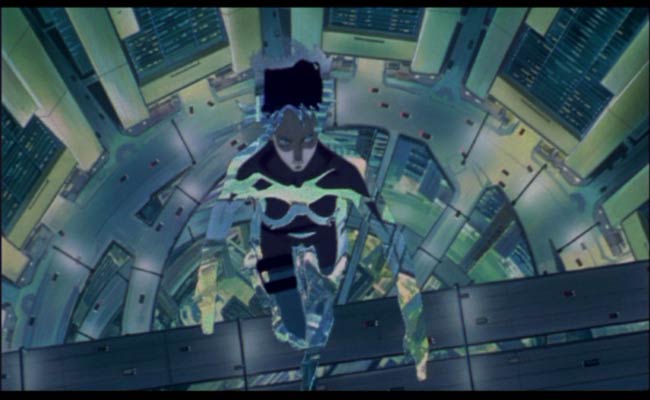
Overview: After Akira, a case can be made for Ghost in the Shell being the most influential anime ever. While Akira was the first anime to crack international markets, GITS rose anime to something “real,”, and opened the doors for events like Disney’s pursuit of Miyazaki, and eventually, the truly incredibly pace of anime we see today. More important for cyberpunk films, GITS provided a myriad of thoughts and visuals that have been expanded upon in virtually all subsequent cyberpunk animes. James Cameron refers to GITS as the first truly adult animation film to reach a level of literary and visual excellence.” In addition to a wonderfully complex and introspective story, we get heart-thumping, realistic action, all served up with some incredibly revolutionary animation techniques that places GITS on a juicy platter for all to enjoy.
~ Fair warning - there are a few plot spoilers below in the matrix discussion - I simply couldn’t write this, especially with linkages to the Matrix without including an interpretation of the ending of GITS. ~

GITS shows us a very realistic looking near future set in the year 2029. The visuals are intricately detailed and depict grunge settings next to the highly sanitized corporate world. In 2029, people have the ability to augment their bodies with cybernetic replacement parts. In some cases, people have almost fully replaced their human bodies, leaving only their brain encased in a cyborg shell. The brain is even augmented with hyper-intelligent access to knowledge and communication packages. But the person, and we use that term loosely now, still has a ghost, or soul if you will - an emergent property of life that separates a human from a robot. Even though the majority of their human material is replaced with a cyborg-like shell, if the individual retains their ghost, they still retain their personality and individuality - their humanity if you will.
This cyborg shell is not the same as a robot. The limbs and body still communicate with the brain in a digital nervous-system-like operation. If we include Masume Shirow’s vision (the writer for GITS), the cyborg’s sexual parts are even fully functional. This means that in essence, their cyborg shell aids in the creation of an individual’s ghost. While this is terrific, a downside is the ability for evil-doers to engage in Ghosthacking - or the taking over of someone’s perceptual control, or worse, augmenting their artificially enhanced memory.
The story centers on Major Motoko Kusanagi, an almost fully mechanically enhanced cyborg secret operative working for Section 9 - Japan’s anti-terrorism division. As the movie progresses Motoko and her cyborg partner, Batau start to uncover a plot involving another ministry that seems to be engaged in a cover-up. Eventually, we find that this cover-up involves a seemingly nefarious hacker named the Puppet Master. In pursuing the Puppet Master, Motoko finds out that all is not what it seems- that in fact the Puppet Master is a sentient program, and never had a body. More interesting, the Puppet Master has been looking for Motoko!
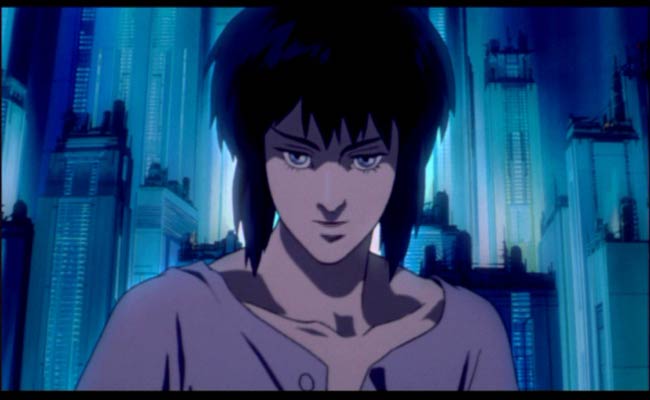
Revolutionizing Anime: Oshii revolutionized animation in GITS with a myriad of new and innovative computer graphics techniques. In short, Oshii pushed the boundaries for state-of-the art animation with GITS. Oshi scanned his animation cells in to a digital system so that he could import them into an editing suite to get all sorts of cool lens effects. For instance, in the above pic, Oshii is able to emulate a contra-pull type effect where the camera moves back, and the lens moves forward. In viewing this, the background expands while the foreground eerily stays in the same place. This works wonderfully for Motoko’s questioning of humanity speech. And this is only one of many interesting used of digital shots. Other techniques include interesting overlays that depict either brain activity or maps, for instance.
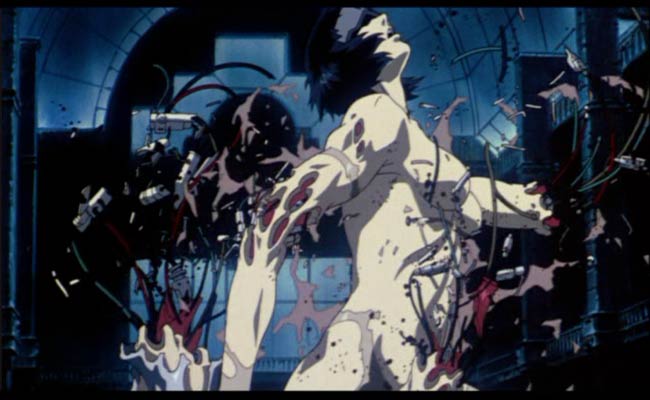
Questioning Humanity: Ghost in the Shell still provides anime’s the best examination in the questioning humanity. GITS is dominated by an ongoing discussion of what it means to be human and really, what it means to be alive. Is Motoko really still human? Even she doesn’t know the answer anymore, and actually questions whether she really has a ghost (how would she be able to differentiate a fake ghost from a real one?). This line of questioning is artfully developed in a way that makes Motoko the character in all of anime that I empathize with the most. You truly feel for the dilemma she finds herself facing.
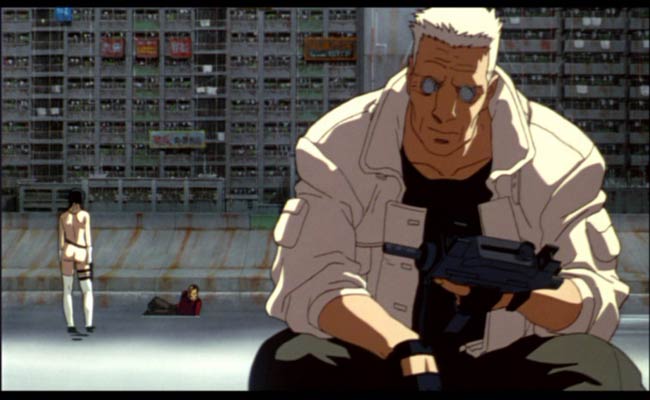
What is the Matrix? If we examine the Matrix, we find that both the visuals and storyline are heavily influenced by Ghost. There are some rather explicit visual “nods” in the first Matrix, including the opening digital sequence, Mr. Smith’s building jump where he breaks the concrete beneath him (this is virtually identical to Motoko pursuing the first puppet victim), and the shooting of the fruit stand where Neo is running near the end. On top of this, we have a reversal of roles in the Matrix, where Neo plays Motoko and Trinity emulates Batau. And again, the Wachowskis make no bones about where their influence came from - they, as much as anyone, have contributed to Ghost’s ever increasing popularity.
In looking at the storyline, we find even more interesting parallels. Ghost in the Shell ends with Motoko merging with the sentient program called the Puppet Master (Project 2501). This allows the Puppet Master produce a diversity of offspring that is simply not possible to do with copies alone. This has a direct parallel to the scifi view of Neo in the above review. While Ghost in the Shell 2: Innocence is the philosophical sequel to Avalon, the Matrix trilogy is just as clearly the sequel to Ghost in the Shell. Whereas GITS ends with this merging of a sentient program with a human ghost, the Matrix expands on this idea. We see Neo take the same journey, but in a very different way. He conducts this symbiotic merging over 3 movies whereas Motoko does this in a matter of minutes. We see Neo, through this merging of sentient program with a human, become the “one” - an omnipotent style being. This characterization is similar to the characterization that Batau gives of Motoko in GITS2 in his dogs and gods versus flawed humans speech.
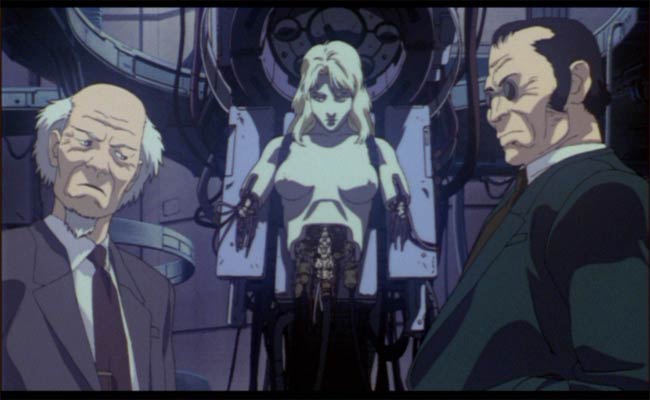
Also interesting is the linkage between the puppet master’s desire to digitally produce offspring with Neo’s reloading of the Matrix. The puppet master discusses this at the end of GITS in the “Life perpetuates itself through diversity and this includes the ability to sacrifice itself when necessary” monologue. If you trace the linkages, Neo’s reloading of the Matrix this is a method for the sentient program portion of Neo to create diversity and offspring. The merging of Neo allows the sentient program to grow and develop in ways simply not possible by itself. Familiarity with Neo’s Ghost allows it to make the changes necessary to correct the errors that build up in the current Matrix that prompt the battery people to disbelieve their surrounding.
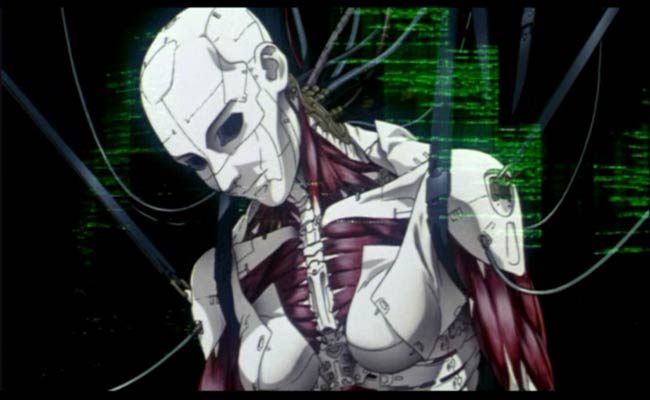
Finally, Ghost gives us a truly interesting vision of the future. We get sound astoundingly realistic and grungy cityscapes that are filled with the most impressive technological horrors. Is it truly a stretch to imagine that technology will augment our physical abilities? This is the bionic man taken to another level. On top of this, if we truly can learn to connect manufactured parts to our nervous system, is it really that far of a stretch to imagine that our brains become augmented? And over time, is it truly a stretch to believe that the line between humanity and robot won’t be blurred? GITS questions these articles of faith in such a believable way that we have seen a shift in our overall thinking on this issue.
The Bottom Line: Truly, even if you ignore all this philosophical stuff, Ghost in the Shell is simply an awesome movie! The action is terrific, the visuals are great, the soundtrack is devine…I could go on and on. If you just see one anime, Ghost in the Shell, still my favorite anime, is hands down the one to get.
Page 2: More GITS Screencaps –>>
~See movies similar to this one~
Tags: cyberpunk movie review anime ghost shell





Comments
January 22, 2006
Sherry said:
This movie looks awesome, I was given the movie as a gift by a wonderful person(odd to be sure) but after reading your review.. I really must watch ASAP!!
SFAM said:
Thanks Sherry! I’m guessing you will love it. It’s a deeply contemplative movie with terrific action breaks.
amberlita said:
Ah yes. The only reason I saw this movie was from it’s repeated presence on your lists. Pretty excellent too. I think it bears rewatching to fully grasp not only some of the ideas but some of it’s strengths as well.
SFAM said:
Thanks Amber! It’s always cool to see when my reviews have an impact on someone’s watching habits. I must say though, I kind of like the site idea for posting these reviews more than the list idea. There is lots more I can do here, especially in terms of creating a relationship structure.
I almost want to start up another site on Sword and Sorcery movies, as I have just about as many of these (around 100 or more) as I do cyberpunk-type flicks.
*Goes in search of an available URL*
February 4, 2006
cyberpunkreview.com » The Matrix Trilogy: A Man-Machine Interface Perspective said (pingback):
[…] I will probably write a separate essay on this, but just to be clear, this viewpoint shows that the Matrix trilogy is the philosophical sequel to Ghost in the Shell (GITS). GITS2: Innocence does not follow Motoko’s journey after she integrates – Neo does. GITS2: Innocence is really a furthering of the philosophies that Oshii advanced in Avalon, meaning that conceptually, GITS2: Innocence is the sequel to Avalon, not the original GITS. […]
February 6, 2006
Jordan Meeter said:
Wow, this is an excellent review! Thank you so much for this, as well as the information you left in the comment on my blog. Very useful indeed. :]
SFAM said:
Welcome Jordan!
Glad you liked the review. I think you’ll find there’s a bunch of great animes out there for GITS: SAC fans. I think GITS: SAC (yet to be reviewed by me, but I will do this soon) is bringing a whole new level of interest to cyberpunk anime, and hopefully to cyberpunk as a whole. Its the perfect entry show.
February 20, 2006
Neuromancer said:
Thanks for a great review!
Mamoru Oshii is truly a master of making multilayered movies where-in “heavy” philosophical themes are made accessible by astonishing imagery. This is groundbreaking work in storytelling, design and used techniques. Truly a landmark in the genre and probably beyand as well.
Music is often underrated but in this movie the work from Kenji Kawai can not be missed and becomes a part of the story. In my mind, the scene where Motoko is constructed simply would not be as strong as it is now without this wonderfull music to complement it.
SFAM said:
Hi Neuromancer, great point about the music. Definitely this plays a big part in setting the mood. And it’s absolutely a landmark - I put Ghost in the Shell in the top three movies needed to understand the genre (Metropolis and Blade Runner being the other two).
March 5, 2006
DannyV_El_Acme said:
Although written originally by Masamune Shirow, the Ghost In The Shell film is incredibly different in mood to Shirow’s original work, and is a superior product for it. This is Oshii’s baby all the way. It’s very interesting to compare it to the original manga, because even though the original story is the same, the mood and presentation couldn’t be further apart. The Ghost In The Shell manga is to put it bluntly, quite laughable. Tons of dumb comic-relief moments, frankly exploitative scenes that serve no purpose(the Motoko-two female cyborg-lesbian sex scene), dumb subplots(the Fuchikoma revolution) and oodles of meaningless psychobabble drag the manga to an almost unreadable point. Oshii discarded everything that was superflous about the manga and streamlined all plot and themes into a coherent, engaging, and highly philosophical work.
I saw this movie when it came out and I haven’t seen it since, I really need to get a copy of it to analyze it better.
SFAM said:
Hi DannyV_El_Acme, welcome to Cyberpunk Review! Hope you like it here. While I definitely agree that I like Oshii’s work better than the Manga, I disagree that Shirow’s manga is laughable. It certainly had a very different (lighter) tone than Oshii’s stuff. And Oshii only used some of the story - interestingly, other parts have come out in GITS SAC. As for the little tryst, I don’t really mind this much, as it sort of clarifies a few things - Oshii never discusses the possibility of Motoko having the ability to have human experiences like that, whereas Shirow makes it absolutely clear that the Cyborg body has been fully wired. I will say that I like Shirow’s sequel - Man-Machine Interface lots better.
May 14, 2006
Desirina.com » Ghost in the Shell (the movie) said (pingback):
[…] There is a more complete review of the movie at cyberpunkreview.com, with screen caps and stuff, so if you want to know more about the movie, check it out. SFAM also has some thoughts about connections between GITS and The Matrix which are interesting. […]
August 16, 2006
cyberpunkreview.com » Dose - Interview With Gene Generation’s Pearry Reginald Teo said (pingback):
[…] […]
March 9, 2007
Saruwatari said:
Ghost in the shell in my opinion is by far the greatest manga/anime in the history and japanese animation. Ferthur more the first movie is the better one out of th two in innocence i got the feeling of lonely without motoko kusanagi. Having said that out of the two movies innocence does rob you of your emotions and you feel the suffering that batou is feeling without the major by his side.
March 18, 2007
Joshoewaa said:
I love this movie, its probably my favourite anime. The climax of the movie is supurb, its so atmospheric. The city’s visuals are amazing…
SFAM said:
Hi Joshoewaa, I couldn’t agree with you more. GITS is still my favorite anime.
March 29, 2007
David said:
I seen this anime when I was 12, and aside from the realistic artwork and backgrounds, I was board outta my my. I remember rewatching it a year later just for the naked shots of Pusunagi and the puppet master’s female body.
The story is pretty similar to the first two Palalabor movies, which, since they share the same director as Ghost In The Shell, is inevitable I suppose. It uses alot of philosophy, slow driven plot, and character introspection, which at times can envoke a ‘ghostly’ feeling, while at others it’s just plain tedium. I recall myself dozing off at the end when te sniper was flying overhead the building, thinking ’shit this is boring…’
If I had to chose ‘the greatest anime of all time,’ I would have to chose three, because it would be incredibly hard to define ‘the greatest.’ BUT, Ghost In The Shell wouldn;t be amongst those three.
April 3, 2007
James NIGDEF said:
Regardless of this being an anime film it is a truly fascinating piece of work, exquisitely paced and directed and that asks challenging questions about identity and technology. The art is beautiful (these urban backgrounds!) and a lot more tasteful and consistent than the expensive CGI crap of its unfortunate sequel. It is a shame that the english dubbing is so bad: the characters’ voices are too monotonous and expressionless and it doesn’t do justice to the great dialogue. Apart from that, it’s all good.
June 4, 2007
randomrob said:
I’m still hoping Bandai will get permission to redub this film w/the GITS SAC american voice actors… I would like to hear Mary Elizabeth McGlynn do Motoko’s dialogue.. IMO she’s really made the Major her own woman..
As for the endless whining about Innocence- only Mamoru Oshii could’ve brought that manga to the screen at that time in the way he chose to do it (ie- editing the crap out of the source) and have been taken seriously. Masamune Shirow had nothing to do with Innocence.. it was Oshii’s baby, and a way for him to continue to expand on the themes he was pulling from Shirow.
IE- cyberpunk itself has been fleshed out as a genre to a bigger audience than it ever has before because of GITS, and because of Oshii, who dared to make it unflinchingly serious.
Ergo: what makes you love GITS is what makes you loathe Innocence.
Go figure.
(somebody wake me up when they make a GITS SAC MMORPG pleeeeease)
I can dream
July 1, 2007
PSY said:
IMO this is one of the few instances where the adaptation is better than the original. God only knows how many times I’ve watched this over the years, and God only knows how many more times I will watch it. One of those films you show people that believe “Anime is like, DBZ yeah?” to show them the error of their ways.
It has many critics, most of which I find tend to hate it because “It doesn’t make sense.” or “There is no story!”. But we live in a world where we are spoon fed our plotlines, so it is to be expected. I for one am greatfull for the chance to exercise the ol’ noggin’.
July 3, 2007
project_2501 said:
Brilliant film, but I didn’t understand the secene where Arakami is in the woods with all the soldiers - what happened then?
Also - On the Akira DVD, there’s a quote that says something like ‘without Akira, there’d be no Matrix’. The only thing from Akira I can think of that’s also in the Matrix is Tetsuo stopping the tank shell. I would have thought GITS was much more influential on the W. bros…
July 16, 2007
Jay said:
I think it’s awesome that you saw the connection between The Matrix and GITS, sicne they are both largely based on the philosophy of Jean Baudrillard. If you haven’t read up on him yet, I highly recommend it. He’s one of the main theoreticians of hyperreality - the idea that in hi-tech cultures we are apt to confuse fantasy with reality.
Awesome review too. Nice read. I’ll be sure to check this site in the future.
July 17, 2007
SFAM said:
Hi Jay, I actually read Baudrillard in college (I took some semiotics courses). And yeah project_2501, I would definitely agree that GITS was far more influential on the Matrix trilogy. But Akira is definitely one of the main stopping points on the road to where we got, so who knows.
October 16, 2008
hell said:
movie
October 30, 2008
kabukiman said:
I saw the movie about 10 years ago and I stunned by it’s visual and philosophical issues. I have buy it, as the manga. They are very different, but the movie follows the end of the manga very closely in it’s spirit. The SAC are also very good, but are less about escathologic issues, and more about espionage and action. By the way, what did you think about man-machine interface?
kabukiman said:
Oh, and congratulations for the site, it’s excelent. I come here nearly everyday since I discovered some months ago, and I haven’t explored all.
October 31, 2008
Stormtrooper of Death said:
Hello Kabukiman, this site has also an excellent and up-to-date forum…
November 10, 2008
suke said:
thanks for this review… well also this comment is like obvious I would like to add to the part of the matrix, the first part where neo discoveres that he is in an emulated life, I think it is very similar to GITS where the garbage collector discovers that his life(wife and daughter) is all emulated by the hacker
suke said:
congrats for the site its great
June 10, 2010
belodeau said:
“It’s a f***ing toaster!”
I’d be interested in a comparison essay between GITS and the new Battlestar Galactica series. What is the line between humanity and not, once AI becomes sentient, etc…
June 12, 2010
Stormtrooper of Death said:
Belodeau, thanks for the comment.
“Its a fuc…ing toaster..”
hehe, when i have to choose between a hot female humanoid and a toaster… I go for the female humanoid…. hehe.
April 4, 2011
Nathan said:
Just saw the two movies after looking through your website. I’m completely amazed, and I’m deeply grateful to you for writing this article and entertaining such a great website.
Thanks SFAM!
Nathan.
June 9, 2011
jone4s said:
Hello, i made a little crappy Ghost in the shell fan music video… i hope its ok to post it here.. maybe i post it in the forum as well…
i like Ghost in the shell (only the movie!) very much…and cyberpunk in general as well too…
http://www.youtube.com/watch?v=aNcYMFx3iyk
November 26, 2011
Van Fanel said:
Una excelente película, sobre todo por que trata sobre si una maquina puede tener alma y el tremendo poder y responsabilidad que esto implica, el mismo nombre de las películas y serie lo remarca
June 14, 2012
Joe peters said:
was it really the end of Ghost in The Shell find out here, http://www.mangauk.com/index.php?p=vanishing-point